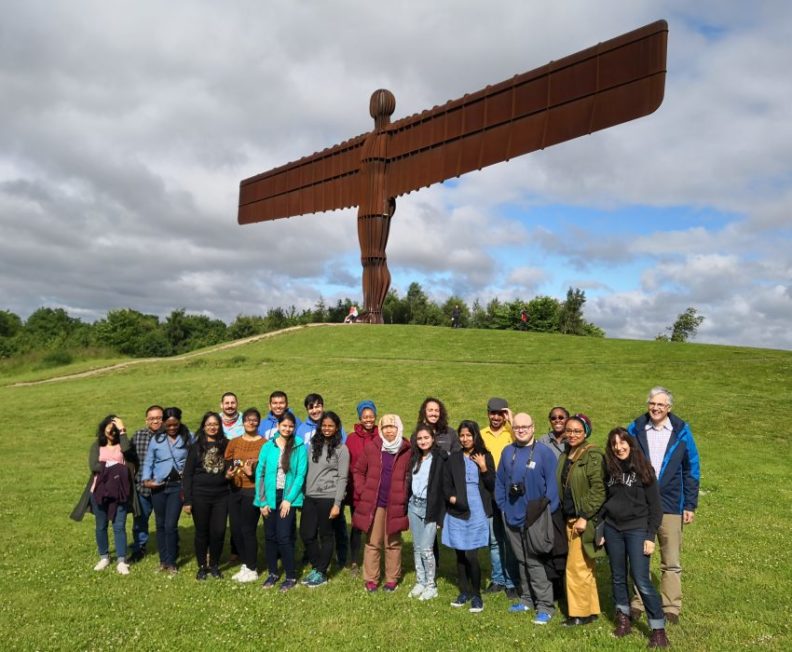Impact of Pandemics on Cultural Heritage
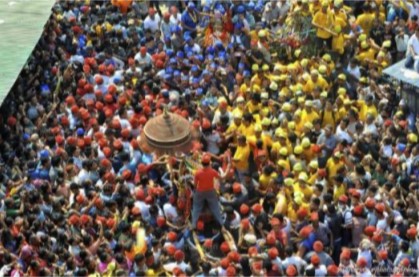
ICOMOS Nepal organized a video conference on 15 April 2020 to discuss the theme “Impact of Pandemics on Cultural Heritage” to prepare this short report for the International Day for Monuments and Sites 2020 theme of “Shared Cultures, Shared Heritage, Shared Responsibility”. The paper was compiled based on contributions by ICOMOS Nepal Members.
INTRODUCTION
The circumstances due to the pandemic
Due to the COVID-19 pandemic the Government of Nepal has enforced a lock-down since 24th March 2020, which has been extended several times, most recently till the end of April 2020.
The only way to deal with this highly contagious virus is to ensure that it doesn’t spread, which means reducing interhuman contact. The lock-down has made sure that people stay at home unless for essential movement. People must not gather, must keep a distance from each other, possibly wear a mask and gloves. Such required behaviour has hindered community interaction.What are the implications on tangible and intangible cultural heritage?
The ‘pandemic disaster’
A lot of discussions have been carried out on the impact of armed conflict and natural disasters on cultural heritage. In Nepal there was an insurgency and political unrest between 1996 and 2006. This was followed by an earthquake in 2011 and an even larger one in 2015. We are still struggling with understanding and dealing with the impact of these disastrous events. There was
little inkling of an even more intrusive disaster that was eminent. An invisible hazard that moved from human to human, breaking down the fabric of community, the basis for resilience and continuity of cultural heritage. How do we deal with this?
ASSESSING IMPACT
Impact on socio-cultural activities
Many festivals that would have taken place during the lock-down period have been affected. Events that require many people to gather have not taken place. This has had an impact on the specific cultural activity, as well as to the related social interaction. It has not only been the big festivals but also the smaller events such as the annual meetings and feasts of the various guthis (community associations) which also have an impact on the functioning as a community. How can the long-term continuity of these activities be ensured? Is it possible to be better prepared, and if so, what would this require?
Impact on museums and virtual access to cultural heritage
Due to the lock-down museums have been closed. There are examples of museums that have gone on-line with their exhibits, providing digital tours. How can museums take on the role of continued interest in cultural heritage? What are the requirements for attractive on-line exhibition and dissemination of information?
Impact on economy at all levels
The COVID-19 pandemic will have a great impact on the economy at all levels: global, national as well as local which is yet to be anlaysed With limited resources, the budget for the
culture sector is usually the first to be cut. However, the immediate impact is on greatest for the local people who are daily wage workers or owners of small shops and stalls directly linked to heritage sites and activities. Will the longer-term impact be the lack of resources for the culture sector in the coming years? How can cultural heritage be linked to the multi-trillion-dollar tourism sector, which will surely suffer, but will have the resources to ensure resurgence?
Immediate impact on intangible rather than tangible heritage
The lock-down that has been enforced due to the pandemic has had direct impact on intangible heritage. Activities that have been carried out annually for centuries have been altered. This could in the long-term also have an impact on tangible heritage, due to lack of maintenance and protection, reduced funding, as well as loss of related beliefs and activities. What can be done in preparations towards responding to such threats?
Scenario of international support
The websites of the international agencies and advisory bodies have pages addressing the pandemic: UNESCO, ICOMOS and ICCROM. These reflect a rather helpless situation we find
ourselves in. Discussions have just begun on what the world will be like after the pandemic. If we refer to the recent United Nations
report “Shared Responsibility, Global Solidarity: Responding to the socio-economic impacts of COVID-19”, ‘culture’ is not mentioned, with a single mention that “access to educational and cultural resources can be used to overcome social isolation”. This raises the question of relevance of such a report for a country like Nepal, where lives of people are still closely associated with cultural heritage.
Lack of understanding of impact of pandemic
With little preparation done for such an event, and presently being in lock-down, it is difficult to assess the overall impact of the pandemic, as well as specifically for the culture sector. As
mentioned, Nepal has not yet recovered fully from the 2015 Gorkha Earthquake and will now have to deal with the
omplications of a new situation caused by the COVID Pandemic.
POSITIVE STORIES AND WAY FORWARD
Resilience of traditional systems
There have been many disasters in the past including pandemics. The cultural heritage that has survived has remained relevant because of its resilience. When big events are not possible, smaller ‘emergency’ rituals are carried out in response to the circumstances. Many cultural activities are being carried out, possibly in a very different manner. Instead of involving the larger community, people are carrying out rituals within their homes, on terraces and in the gardens, with the participation of family members. These
are standardized rituals that are carried out when people cannot go to the temples or join larger congregations. Such systems have already been put in place to ensure resilience during emergency situations.
Take a break!
The pandemic has stopped the world in their stride and has raised many questions particularly concerning sustainability. We have all seen the positive impact on the environment. The air has become much cleaner. This will generally have a positive impact on our natural environment, as well as our cultural heritage sites. Will there be a positive long-term impact? We need to work
towards this.
Communication through modern technology
Modern technology through internet and various apps has allowed for communication throughout the world while staying in lock-down, without physical contact. We will still need to better understand how to use this technology to replace that which we have lost. The physical contact and participation in activities that we have lost for a short duration or could this last longer? These discussions might need to be picked up on social media. Access to and involvement in cultural discussions can be promoted through various forms of modern technology. This needs to be further explored.
EXAMPLES OF IMPACT
Continuity of the rituals despite the pandemic Contribution by Anie Joshi
The festival season in Kathmandu Valley starts March-April each year with great enthusiasm and festivity on the streets and squares, the Jatra. But in 2020, the beginning of the festivity was limited within the houses of god and people, with the streets empty and silence of pandemic.
The various associated Guthis for the festivals took the responsibility of continued rituals within the temples and Jatra halted as social distancing has been a major priority during this extraordinary situation in the world. People participated in the rituals in social distance with the deities by making the offerings from the terrace parapets, Palli Puja, which is a general practice of apologizing to the deity when they could not physically reach the house of God for unavoidable circumstances.
In the historic town of Sankhu, a 12- day long festival of Vajrayogini Khat Jatra takes place during this period when the goddesses Vajrayogini visits the people of Sankhu. The Jatra Management Committee along with local government and the priests, Gurujus, responsible for the rituals had several meetings to discuss on how to deal this unprecedented situation of their lifetime.
As per the recorded history, the Jatra was halted in 1674 (N.S. 794) while mourning when King Pratap Malla died as mentioned by Mr. Prakash Man Shrestha, a local historian based on his collection. As these festivals are associated with the prosperity and wellbeing of the community, the decisions to halt the Jatra was aligned with its purpose, the wellbeing of the people. All the ritual practices associated were completed in presence of the priest family, Guthi representatives and the Jatra Management Committee. A ritual for forgiveness, Chema Puja, initiated the formal 12-day rituals and on the 8th day the Shanti homa, an immolation of the offerings in fire concluded the Jatra though the rituals continue till the 12th day in the temple premises.
In the historic town of Bhaktapur and Thimi, Bisket Jatra commences with the hoisting of Yoshi, the ceremonial pole with much jubilance. However, with the restrictions on the large gathering due to pandemic, the Jatra was called off and instead of the 55-hand long Yoshi, a smaller 4-5 inches golden pole was symbolically placed for the ritual practice as mentioned by the locals Mr. Tulsi Ram and Laxmi Prasad Rajchal from Bhaktapur. Most of the people made offerings to the deity from their terraces while some of the people were seen going to the squares and temples for the ritual activities.
Paachare (Ghode Jatra) Contributed by Monalisa Maharjan
Paachare is one of the major festivals for the people of Kathmandu. During this time many activities within home, at Guthi and at community level take place like procession of Gods in palanquin, mask dances and so on. Unfortunately, this year except the rituals at home and the important rituals in communal level most of the events were halted to avoid crowds due to COVID 19.
• The ritual to worship the God that is hidden underground throughout the year was worshipped which is known as luka maha dhyo (the hidden Mahadev). On this day we could see many holes dug up in the main street, which is unfortunately impossible as most of the places concrete paved. People continued to worship Luka mahadyo this year as well.
• During Paachere most of the Ajima (mother goddess) is worshipped and this continued in a normal way.
• During such festivals Newa families invite relatives for a feast the following days , nakhtya, to strengthen the family bond and social life. The families whose houses lies within the Jatra route invite relatives on that day to observe the Jatra. But this year families cancelled nakhtyasas the nationwide lockdown was imposed by government just a day after Paachare.
• The event to feed young kids Mara Jaa in different localities was cancelled. Mara Jaa contains rice, lintels, beans and many more other indigents. During this event people who lost their family members also distribute foods like fruits, chocolates, milks etc. as they wish. People have ancient belief that Mara Jaa prevents kids from various diseases.
Nyata Ajima (Swait Kali Ajima Jatra)
One of the main events of Paachare (23rd March) is the procession and dance of Nyata Ajima (Nardevi). Besides worshipping of Ajima, the mother goddess the temple of Nyata (Nardevi), the gods and goddess in human form also appear. Twelve gods and goddess with mask, dress, jewelleries and sword appear. Then after the ritual they dance for night and day. This year the gods and goddess appeared and performed only the most important rituals. The elaborate dance at the dabu (raised platform) of Naradevi was cancelled.
Dhyo lwakeguou Jatra (Khat Jatra) of Ason
During Paachare different Ajimas are brought in palanquin to Ason, which was supposed to take place on 25th March with different groups with different colour caps carrying their own Ajima. They are brought to the Ason and the celebration to exchange traditional torch (masal). Huge mass is gathered during this event. So due to the COVID19, this year this event was cancelled.
Ghode Jatra in Tudikhel
Nepal army used to organize the festival of horse racing in Tudikhel (the large open space within Kathmandu), which also gave the festival name Ghode Jatra for the non Newa community. This public event used to be attended by the highprofile people of the country including the President and Prime Minister. This year just few days ahead of the event Nepal army cancelled it, which was supposed to take place on 24th March.
Recommendation for way forward
Some specific recommendations were made which can be summarized under the following points:
1. Continue study on impact on cultural activities and resilience of the communities towards the pandemic and possibly link
this to overall resilience of local cultural heritage. This would be linked to the traditional knowledge and adaptations that
were made in the past, as well as ‘special provisions’ in traditional systems to overcome difficult circumstances while
ensuring long-term continuity. The transfer of this knowledge to the next generation would need to be facilitated.
2. Continued discussion on these issues through the use of modern technology, such as through social media. This would be closely linked to improving communications through digital means, such as providing access to cultural heritage through virtual walk-through and interactive websites. This would be a means of communication both at local level, but also ensuring international collaboration and involvement.
3. The short and long-term economic impact of the pandemic needs to be carefully observed and measure put in place to respond accordingly. It will be necessary to link the sustainability of cultural activities to other sectors such as tourism, local development and disaster risk management. Resources must be ensured to maintain and protect tangible heritage, by ensuring the resilience and continuity of intangible heritage of the local community.
By Kai Weise
Header photo of Dhyo Lwayekegu Jatra (Khat Jatra) in Ason by © Narayan Maharjan
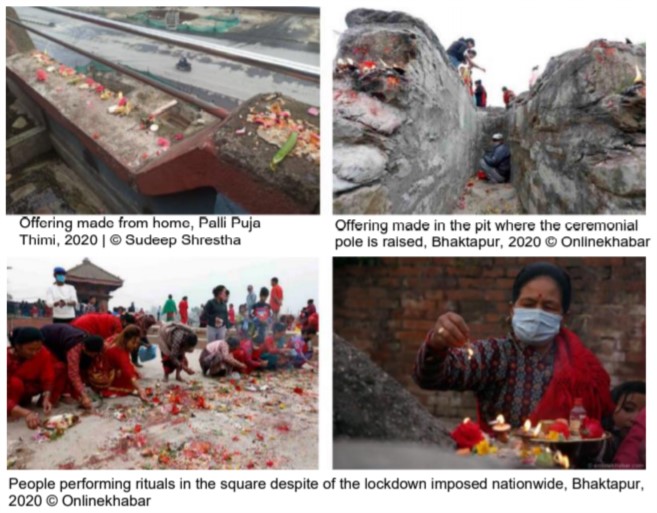
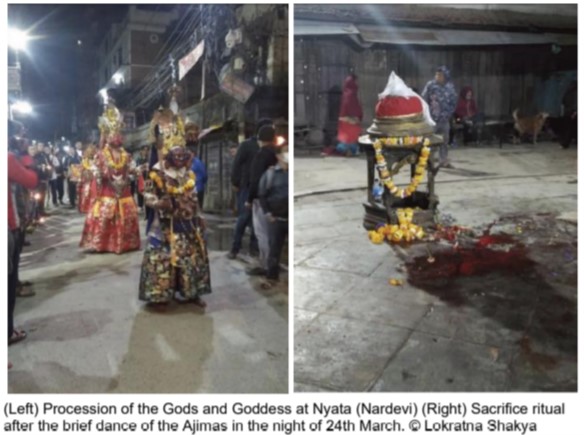 | 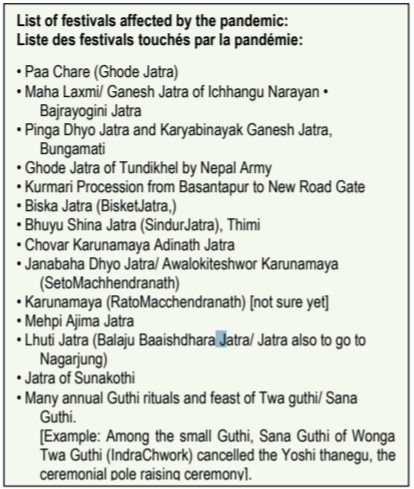 |

